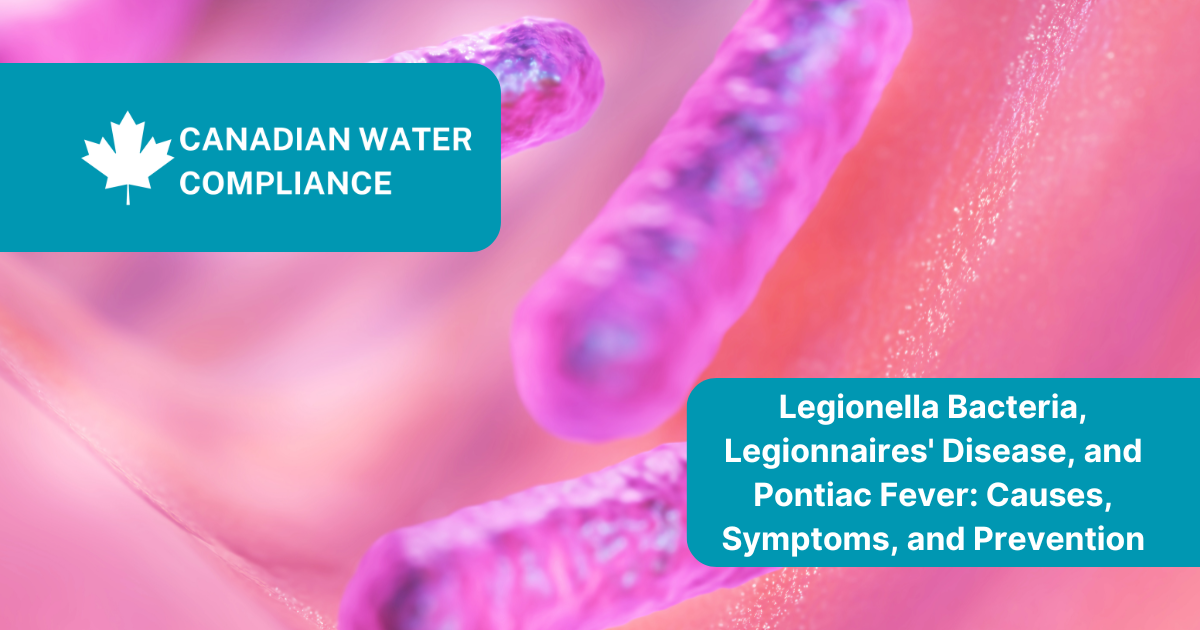
Written By: Canadian Water Compliance | On
Legionella bacteria are responsible for two serious respiratory illnesses: Legionnaires’ disease and Pontiac fever. These illnesses are caused by inhaling water droplets contaminated with Legionella, a bacterium that thrives in warm, stagnant water systems.
📌 Key Facts About Legionella:
✔ First identified in 1976 after an outbreak at an American Legion convention.
✔ Legionnaires’ disease is a severe form of pneumonia with a 10% fatality rate.
✔ Pontiac fever is a milder, flu-like illness with no pneumonia.
✔ Cooling towers, plumbing systems, and hot tubs are common Legionella breeding grounds.
✔ In Ontario, building owners are legally required to test cooling towers for Legionella to prevent outbreaks.
This guide explores how Legionella bacteria proliferate, how they cause disease, their history, symptoms, and strategies for prevention.
Legionella is a type of bacteria found naturally in freshwater environments, such as lakes and rivers. However, it becomes a public health threat when it grows and spreads in human-made water systems, such as:
🚰 Cooling towers (used in HVAC systems)
🚿 Hot water tanks & plumbing systems
💦 Hot tubs & spas
🚽 Fountains, humidifiers, and misting systems
How Does Legionella Spread?
Legionella bacteria multiply in stagnant, warm water (20–50°C / 68–122°F).
They form biofilms that protect them from disinfectants.
Bacteria become airborne through mist or vapor, allowing inhalation into the lungs.
📌 You cannot get Legionnaires’ disease from drinking contaminated water. Infection occurs through inhalation.
Legionnaires’ disease is a severe form of pneumonia that occurs when Legionella bacteria infect the lungs.
Symptoms appear 2–10 days after exposure and include:
✔ High fever (39°C or 102°F and above)
✔ Cough, shortness of breath, and chest pain
✔ Muscle aches, headaches, and chills
✔ Confusion and fatigue
✔ Gastrointestinal issues (nausea, vomiting, diarrhea)
Who is Most at Risk?
🏥 Hospitalized patients & immunocompromised individuals
👴 People over 50
🚬 Smokers & individuals with chronic lung disease
Severe pneumonia, requiring hospitalization.
Respiratory failure, leading to ICU treatment.
Long-term lung damage and complications.
Fatality rate of 10%, increasing to 25% in outbreaks linked to healthcare settings.
📌 Legionnaires' disease requires antibiotic treatment. Early diagnosis improves survival rates.
Pontiac fever is also caused by Legionella but does not cause pneumonia and is less severe than Legionnaires' disease.
✔ Flu-like symptoms (fever, chills, headaches, muscle aches)
✔ No pneumonia or lung infection
✔ Symptoms appear within 1–3 days and resolve without treatment
📌 Unlike Legionnaires’ disease, Pontiac fever does not require antibiotics. It resolves on its own within a few days.
The first recognized Legionnaires’ disease outbreak occurred in July 1976, when attendees of an American Legion convention at the Bellevue-Stratford Hotel in Philadelphia fell ill.
✔ 221 people became sick, and 34 died.
✔ The cause remained unknown for months until January 1977, when researchers identified a new bacterium (Legionella pneumophila) in the hotel’s cooling tower system.
✔ This discovery changed water safety standards worldwide, leading to strict regulations for cooling tower maintenance and water quality testing.
📍 Toronto, Canada (2005): Nursing home outbreak with 127 cases and 21 deaths.
📍 New York, USA (2015): Cooling tower outbreak in the Bronx affected 133 people, with 16 deaths.
📍 Flint, Michigan (2014-2015): Water crisis linked to Legionella resulted in 87 cases and 12 deaths.
📌 Legionella outbreaks continue to occur, making prevention and testing critical for public health.
To prevent outbreaks, building owners must implement water management plans and conduct regular testing.
✅ Test cooling towers monthly (required in Ontario).
✅ Disinfect hot tubs, humidifiers, and plumbing systems regularly.
✅ Monitor water temperatures (keep hot water above 50°C and cold water below 20°C).
✅ Reduce stagnation by flushing pipes and water systems.
✅ Use biocides and chemical treatments in HVAC cooling systems.
📌 Legionella testing is required by law for cooling towers in Ontario under Regulation 428/05.
Ontario enforces strict Legionella testing regulations for building owners and facility managers.
✔ Cooling towers must be tested monthly during operation.
✔ Testing is required when systems are first activated each season.
✔ Facilities must keep test records for at least 5 years.
✔ Immediate disinfection is required if Legionella levels exceed regulatory limits.
🏢 Fines, legal liability, and shutdown orders.
🚨 Public health risks and disease outbreaks.
📉 Reputation damage for businesses and facilities.
📌 If your building has a cooling tower, routine Legionella testing is not optional—it’s the law.
Legionella bacteria pose a serious health risk when they grow in cooling towers, plumbing systems, and hot tubs. Without proper testing, treatment, and water management, outbreaks can occur—leading to severe illness, hospitalizations, and fatalities.
✔ Legionnaires’ disease is a severe pneumonia with a 10% fatality rate.
✔ Pontiac fever is a milder Legionella-related illness with flu-like symptoms.
✔ Cooling towers, plumbing systems, and stagnant water sources are high-risk areas.
✔ Ontario requires regular Legionella testing to prevent outbreaks.
🔎 Need professional Legionella testing? Contact Canadian Water Compliance today to ensure your building meets safety regulations!